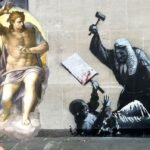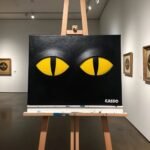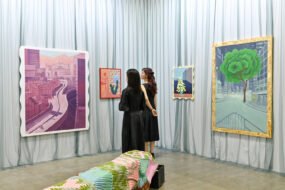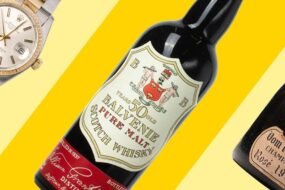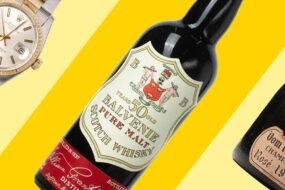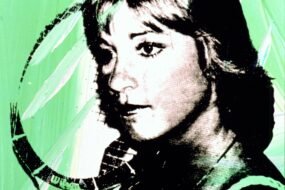
International Folk Art Market guests in front of the IFAM marquee.
© Gabriella Marks; Courtesy of IFAM
Look beyond the art. Beyond the dazzling technique and skill. Beyond the individual artist even. Look all the way back to community. See heritage and ancestors.
There, visitors to the International Folk Art Market in Santa Fe will find the event’s greatest beauty.
International Folk Art Market artisans were asked by organizers in 2024 how many people help make their art? How many other people their work supports? Collaborators dwarf independents. Many of the juried artists work with family members. More work in large, community cooperatives.
“Last year, we had 165 artists, and they employed almost 12,000 people, and of those, 83% of them were women,” Stacey Edgar, Executive Director, International Folk Art Market, told Forbes.com.
That is the impact of folk art around the world. That is what IFAM attendees are supporting when they show up and purchase something.
Artists, families, communities. Women. Female entrepreneurs.
Buying products direct from the maker or producer, be that at the International Folk Art Market or a local farmer’s market, supports families and communities, not multi-national corporations.
The same corporations spending millions to employ lawyers to find new ways of avoiding taxes. The same corporations spending millions on lobbyists to bribe the government to reduce environmental regulations so they can save pennies by polluting more and more easily. More millions to bribe politicians to ease child labor requirements. More millions to fight labor unions. More millions to fight worker protections.
Buying goods–whether that’s food or furniture or clothing–from big, corporate, retail or online stores–the kind that do national advertising, the kind that have franchises in every city in America–does greater damage to the planet and more likely abuses workers and communities than buying direct from the maker. “Shop small” is a global trend for a reason. Consumers can’t shop smaller than buying from the maker, and when they do, as evidenced at the International Folk Art Market, their positive impact can be enormous.
International Folk Art Market
International Folk Art Market guest with jewelry artist Phoebe Lasoi Salau of Kenya.
© Gabriella Marks; Courtesy of IFAM
The International Folk Art Market has been honoring the handmade since 2004. The event grew out of Santa Fe’s spectacular International Folk Art Museum when a former museum director, a former head of New Mexico’s Department of Arts and Culture, and a Santa Fe entrepreneur transplanted from New York with experience in the global textile trade decided to move the art shown inside the museum outside. And invite the makers. And offer it for sale.
One thing led to another and while still in partnership, the Museum and the Market are now separate organizations.
“The International Folk Art Market envisions a world that values the dignity and humanity of the handmade, honors timeless cultural traditions, and supports the work of artisans serving as entrepreneurs and catalysts for positive social change,” IFAM’s mission statement reads.
Can’t beat that.
Now, every year, roughly 150 artists are selected from more than 700 applicants around the globe to come to Santa Fe and sell their handiwork. IFAM financially supports their travel. Artisans showing and selling products at the 2025 fair hail from almost 60 countries. India and Mexico have the greatest number. Textiles and jewelry are the art forms best represented. Perfect for gift giving.
“Buying a piece of handmade art opens up your curiosity to the creativity that went into that piece. It makes you want to go down that rabbit hole and know a little bit more about the person behind it,” Edgar said. “You go buy a pair of jeans, you know it was sewn, and unfortunately, that’s the disconnect that happens. There’s a person behind most things that you are wearing or using even if it was (made) in a factory. There are still lots and lots of human lives that make up that factory, it’s just that their faces get taken away. That is what is special about the folk art sector, you are able to connect and hopefully have a better human understanding of that person, their lives, their motivation, their communities, when you learn about their art.”
Edgar began her professional life as a social worker, working with families and communities. Service performed by her mother-in-law as part of the United Nations World Food Program in Ethiopia opened Edgar’s eyes to the potential of art and craft items to impact communities and for women to help women.
“I thought, ‘Wow, I know women who would love to champion these women and provide them a market,’” Edgar remembers.
With $2,000 from a personal tax refund, she started Global Girlfriend, a company which grew to generate $2 million in fair trade sales annually. After being acquired by a larger company 17 years later, Edgar earned a PhD and then taught sustainability and social responsibility at the University of Colorado.
She had been visiting IFAM since 2008 through Global Girlfriend. Artisan groups she was working with were often invited.
“It’s unlike any other experience in the global artisan sector that I had, community art that provides employment,” Edgar explained. “People get to connect directly with the artists. In this global space, there’s a lot of importers like me telling people’s story. When (makers) get to come and tell their own story and showcase their own work and demo how it’s made, that person-to-person diplomacy is absolutely magical.”
In one place, over a three-day weekend in one of America’s most beautiful and arty cities, visitors can meet and shop and buy handmade artisan craft items directly from makers who call South Korea and Kazakhstan and Peru and Kenya home. New Mexico, too.
In recognition of the city of Santa Fe celebrating its 20th anniversary as the first UNESCO “Creative City” in America, IFAM organizers have invited New Mexico folk artists to present along with their global colleagues. Indigenous artists and artists descended from New Mexico’s Spanish colonizers will show at the fair.
“This is a story of bringing that human touch, the handmade, into a tangible object, and bringing the memory of interacting with this artist, this creator, hearing their inspiration,” Edgar said.
Visiting the International Folk Art Market 2025
2024 International Folk Art Market artist cohort enjoying Opening Night Celebration at Railyard Park.
© Gabriella Marks; Courtesy of IFAM
The International Folk Art Market 2025, the largest folk art market in the world, takes place between July 10 and July 13, 2025, at Santa Fe Railyard Park. In addition to artist tents, IFAM has grown to feature dance performances, talks, artist demonstrations, food vendors, and music performances with global vibes.
Artisans are grouped by “neighborhood” depending on their products and backgrounds. The neighborhoods are: Sustainability, Rooted in Place, Innovation, and Women’s Empowerment (the largest).
“Multicolores is a group that takes old T-shirts and upcycles them into the most spectacular, creative rugs. They’ve been coming for many years.” Edgar said as one example of an artisan in the sustainability category. “This year, we have a group called Ocean Soul out of Kenya on the coast and they collect flip flops that have washed up in the oceans as tourist waste, mostly, and they reuse them into these colorful sculptures.”
Fourteen-hundred volunteers support IFAM’s 11-person regular staff in putting on the event. Testament to Santa Fe and New Mexico’s love for the arts and creativity.
“You’ve probably heard New Mexico’s nickname, The Land of Enchantment, it’s on the driver’s license. Artists for years have been coming to Santa Fe, there’s a magic in the landscape. There’s a magic in the people,” Edgar said. “It’s a really interesting cultural blend of Native Americans and Spanish descendants, it’s a real coming together of people, and with that, a coming together of creativity. Such an appreciation for art and making. We have a big maker community.”
Santa Fe belongs to a select group of international cities designated as a City of Folk Art and Craft by UNESCO. The group of UNESCO Creative Cities are chosen by application for innovation, investment, and community in a range of arts and creativity. From cooking pots and water containers crafted in clay by Indigenous artists a thousand years ago through today, to contemporary decorative items and intricate jewelry crafted in textiles, metal, and wood, Santa Fe welcomes, strengthens, and grows arts and artists in its community.
The galleries, the museums, the festivals and markets. With a population around 100,000, the Santa Fe area punches like a metropolis of 10,000,000 when it comes to arts and culture and creativity. Visitors to this year’s International Folk Art Market can simultaneously enjoy SITE Santa Fe’s “International” exhibition with international contemporary art spread across venues around town. The International Folk Art Museum will of course be welcoming market-goers as well.
How we spend our money as consumers makes a tremendous impact. On people. On the planet.
How we spend our money also makes a statement about our values. What do you value? Communities or corporations? Artists or shareholders?

